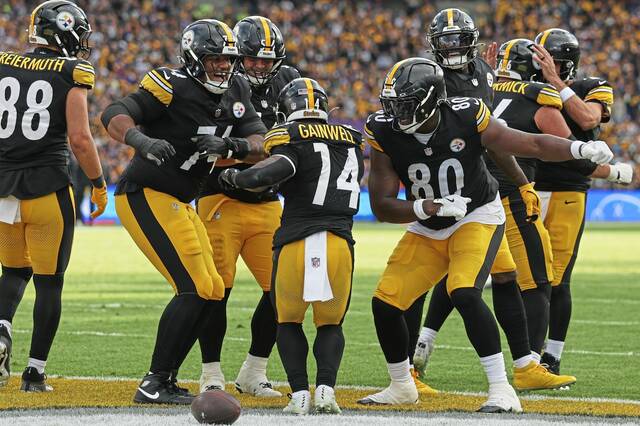Mark Madden: Steelers' prehistoric approach of 7 offensive linemen worked but has its flaws
The Pittsburgh Steelers were founded in 1933.
Right now, they’re using an approach fit for 1933.
Coach Mike Tomlin has become enamored with deploying, for all intents and purposes, seven offensive linemen.
What’s next, the single wing?
Spencer Anderson serves as an extra tackle. He played 19 snaps in the Steelers’ last game, a 24-21 win over Minnesota on Sept. 28 in Dublin.
Darnell Washington is a tight end. But at 6-foot-7, 264 pounds, he’s out there to block. He played 48 snaps against Minnesota and has become the Steelers’ No. 1 tight end. Pat Freiermuth played just 15 snaps at Dublin, Jonnu Smith 13.
Under offensive coordinator Arthur Smith, the attack was supposed to be built around tight ends — but as targets, not blockers. Freiermuth’s salary cap hit is $12.8 million, Smith’s is $5.1 million. Both are essentially on the pay-no-mind list.
The result is that running backs have gotten 64% of the Steelers’ touches.
Is that good or bad?
This method keeps grandpa quarterback Aaron Rodgers mostly upright. He was sacked seven times over the first two games but zero times in Week 3 versus New England and twice at Dublin.
It helps the running game. The Steelers rushed for 131 yards against the Vikings. (The Steelers average a putrid 3.3 yards per rushing attempt, 4.7 yards when Anderson serves as an extra tackle. But does it make the offense too cautious?)
The jumbo package covers up for an offensive line that, despite considerable pedigree, isn’t developing. First-round pick Broderick Jones at left tackle is a disaster. First-round pick Troy Fautanu at right tackle is disappointing. Second-round pick Zach Frazier at center might be regressing a bit after an excellent rookie campaign last season.
This approach may be opponent-specific. It figures to be deployed Sunday at home against Cleveland to counter the threat of premium edge rusher Myles Garrett. Make his path to Rodgers longer and harder.
But when something works, Tomlin keeps using it.
Will seven offensive linemen work against a good team in a big game?
Will it work in a playoff game?
Will it work when the Steelers trail by two scores or more?
In the latter situation, the Steelers can dump out of that approach and get more targets on the field. But would that coalesce quickly enough?
Steelers fans love power football. You don’t hear many complaints.
Except from Freiermuth fans. Maybe, eventually, from Freiermuth himself. Smith, too. This isn’t what they signed up for. But it’s hard to imagine this approach sustaining success.
Personally, I hate it. It’s prehistoric, especially in an era when the emphasis is on scoring more, faster. On extending leads, not merely holding them. Nobody trades points for time anymore.
Look at the Dublin game, when the Steelers were ahead by 18 in the fourth quarter but wound up winning by three.
Tomlin loves one-score games, seemingly to the point of courting them when his team leads by more. That’s a slippery slope, but Tomlin navigates it well: His record in one-score games is 108-65-2, a winning percentage of .617. That’s the NFL’s all-time best mark.
I’m not sure this strategy lets Rodgers be Rodgers. It depletes his options, which weren’t saturated with quality or quantity to begin with.
Is it better to put Rodgers at risk if he might produce more?
Or is this Rodgers not that Rodgers, and Tomlin knows that?
Tomlin will do what he wants. It will invariably be old-school. It will either work or not.
But it hasn’t worked enough for a long time.
Remove the ads from your TribLIVE reading experience but still support the journalists who create the content with TribLIVE Ad-Free.

